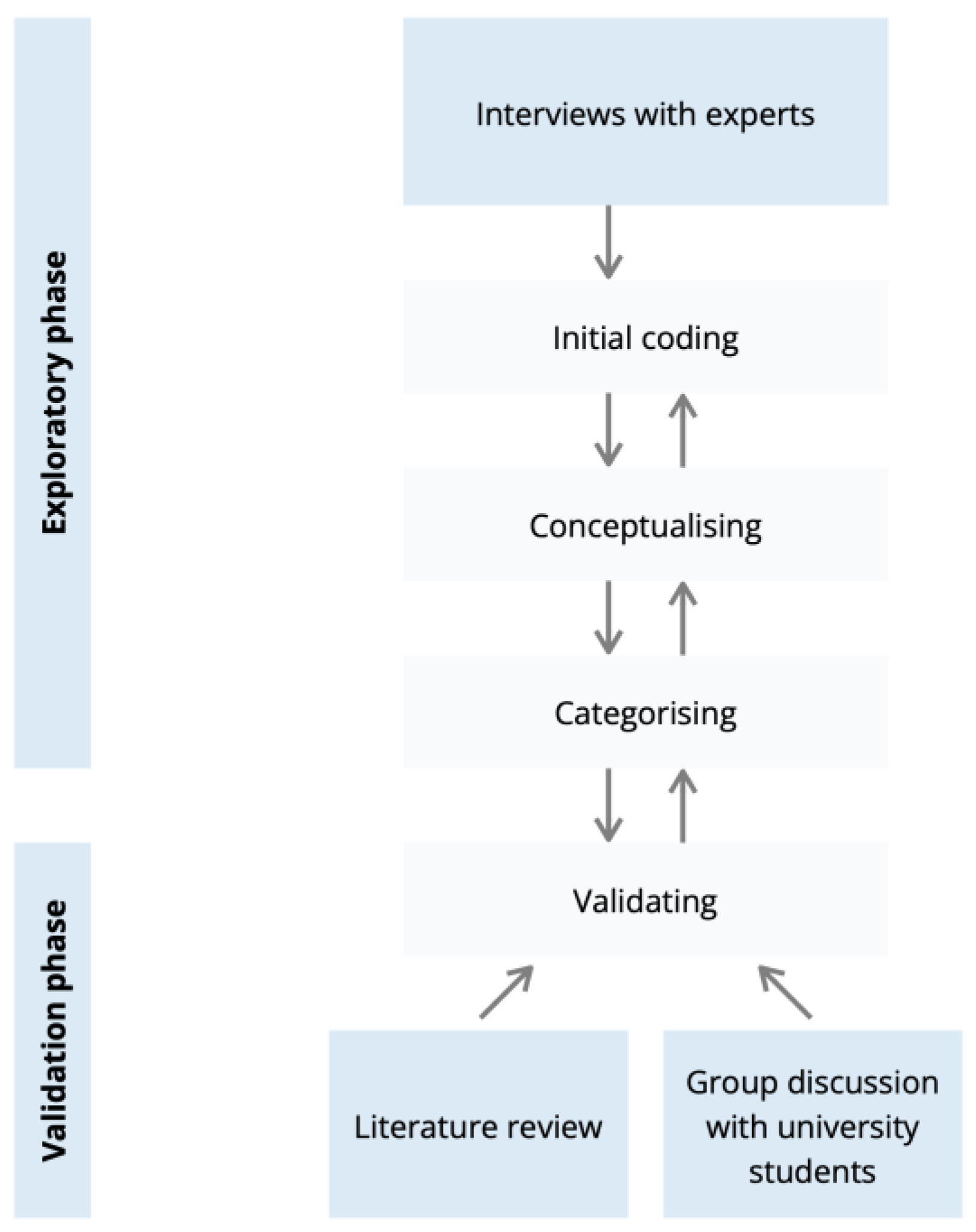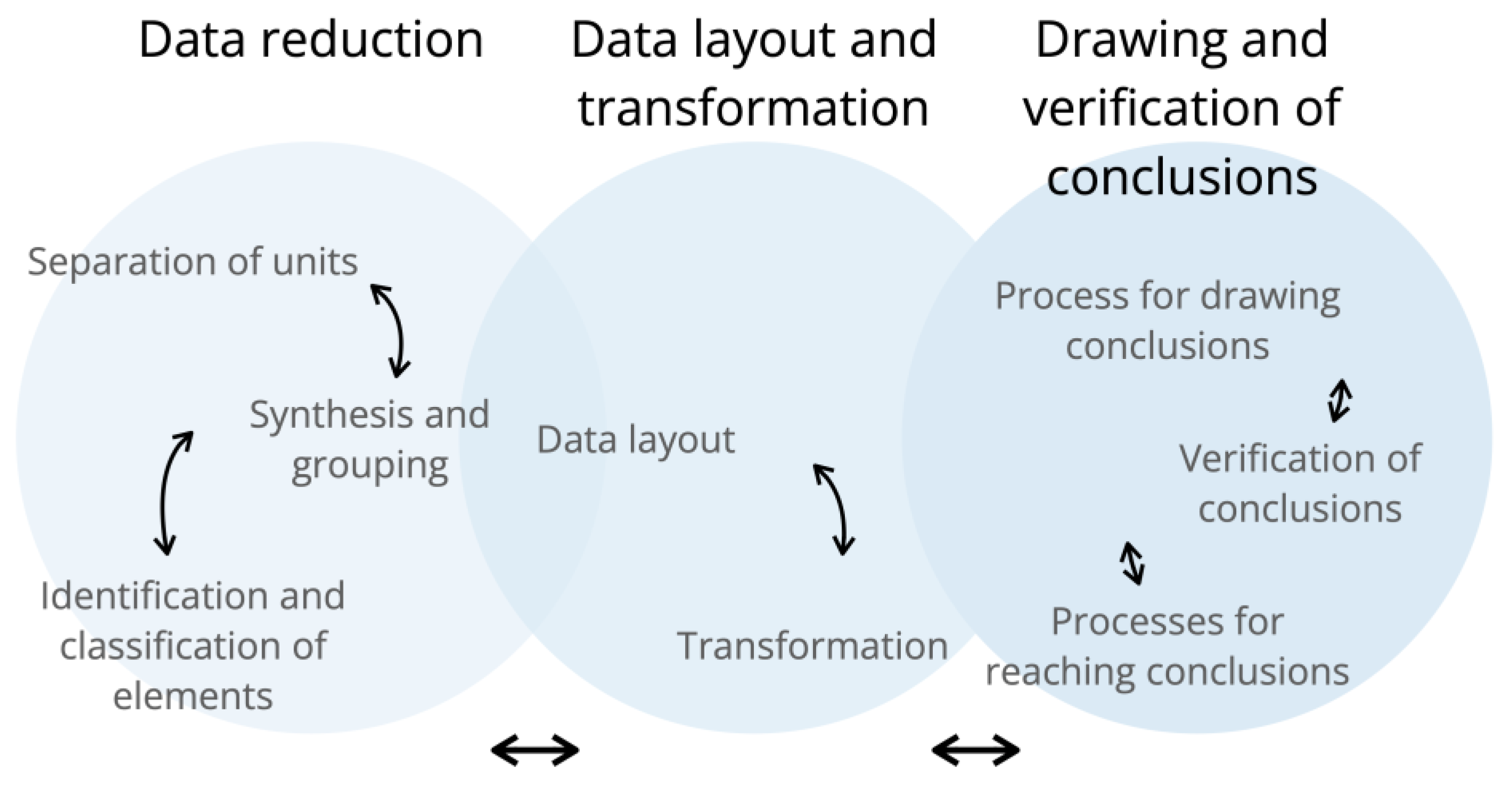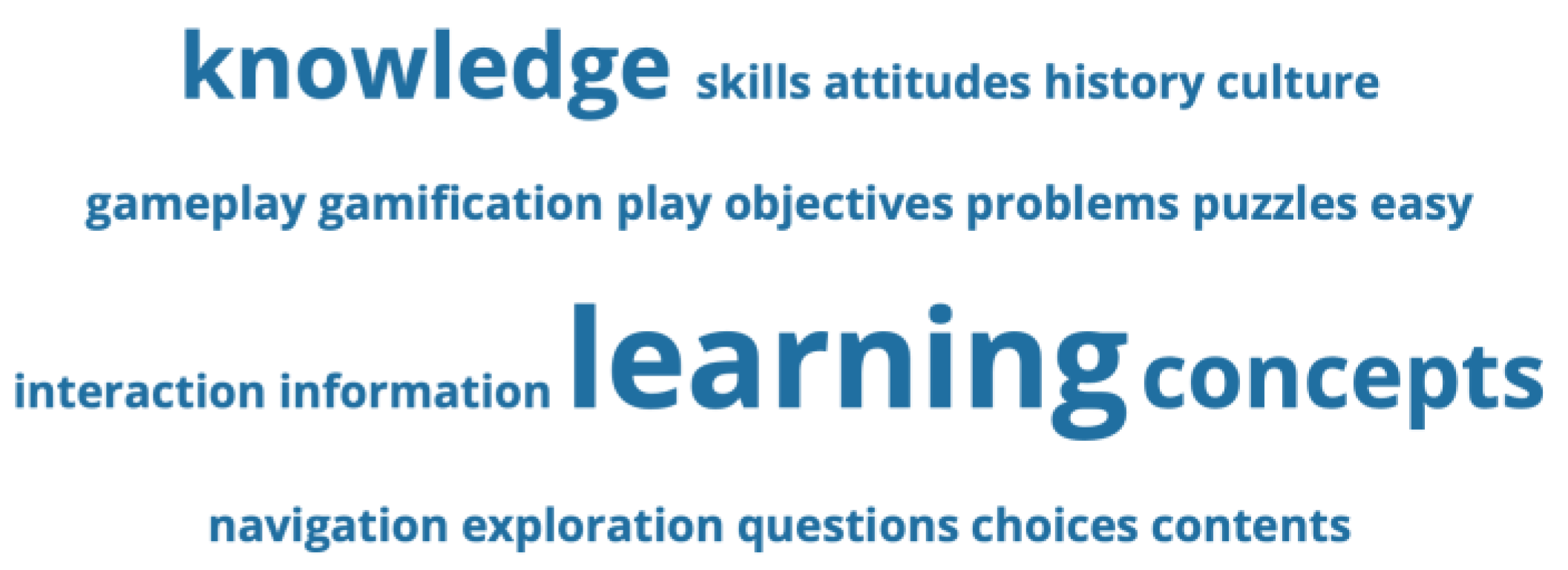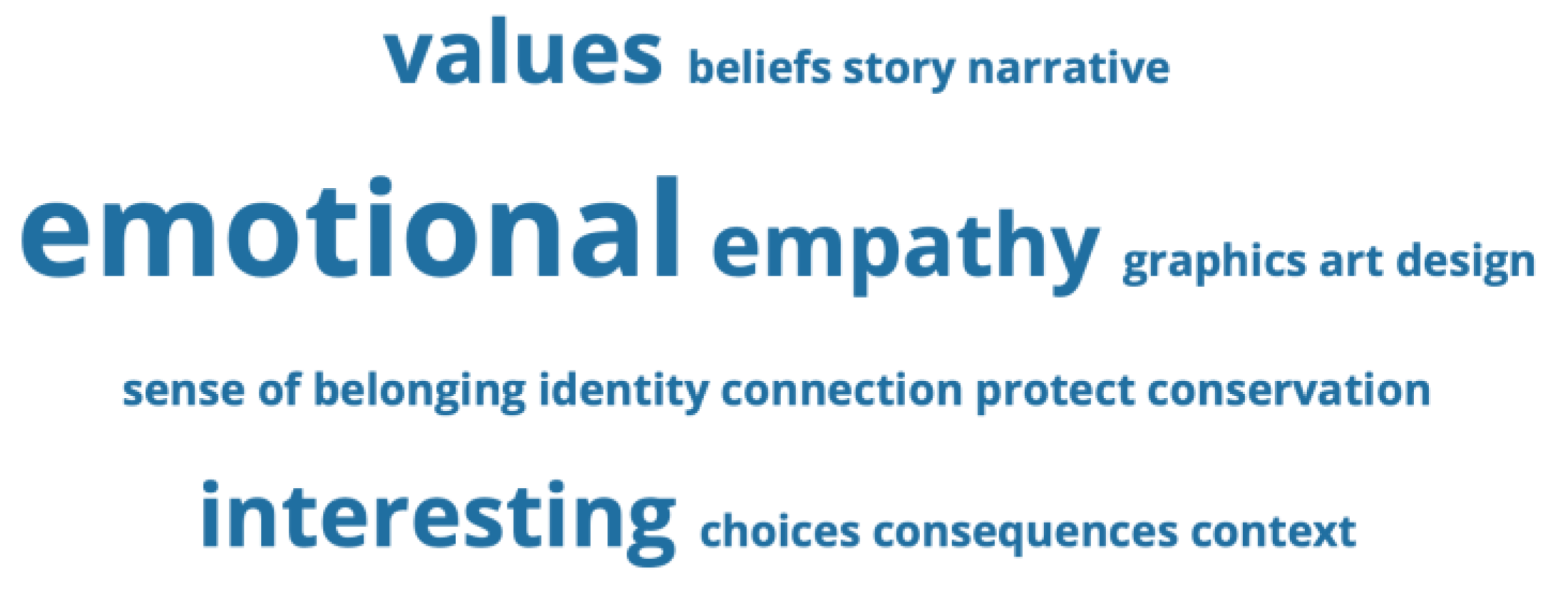Maximizing Engagement with Cultural Heritage through Video Games
Abstract
:1. Introduction
1.1. Defining Cultural Heritage Games
1.2. Defining Engagement
2. Methods
2.1. Methodological Approach
2.2. Data Collection
2.2.1. Interview Procedure
2.2.2. Group Discussion Procedure
2.3. Data Analysis
3. Results
3.1. Easy to Play
3.2. Identity-Driven
3.3. Information Pills
3.4. Meaningful
3.5. Narrative-Driven
3.6. Open-World
3.7. People-Centered
3.8. Simulating
3.9. Task-Driven Learning
3.10. Verisimilitude
4. Discussion and Conclusions
Author Contributions
Funding
Institutional Review Board Statement
Informed Consent Statement
Data Availability Statement
Conflicts of Interest
References
- UNESCO. Communicating World Heritage: A Guide for World Heritage Information Centres; German Commission for UNESCO: Bonn, Germany, 2018; Available online: https://bit.ly/3SC7ice (accessed on 1 October 2022).
- Fontal Merillas, O.; García Ceballos, S.; Arias, B.; Arias, V.B. Assessing the Quality of Heritage Education Programs: Construction and Calibration of the Q-Edutage Scale. Rev. Psicodidáctica 2019, 24, 31–38. [Google Scholar] [CrossRef]
- Ott, M.; Pozzi, F. Towards a new era for Cultural Heritage Education: Discussing the role of ICT. Comput. Hum. Behav. 2011, 27, 1365–1371. [Google Scholar] [CrossRef]
- Makridis, S.; Alexiou, S.; Vrasida, M. The Role of Experience in Shaping Student Perception of the Significance of Cultural Heritage. In Tourism, Culture and Heritage in a Smart Economy; Katsoni, V., Upadhya, A., Stratigea, A., Eds.; Springer: Cham, Switzerland, 2017; pp. 467–482. [Google Scholar] [CrossRef]
- Duarte Alonso, A.; Sakellarios, N.; Pritchard, M. The theory of planned behaviour in the context of cultural heritage tourism. J. Herit. Tour. 2015, 10, 399–416. [Google Scholar] [CrossRef]
- López Fernández, J.A.; Medina, S.; López, M.J.; García Morís, R. Perceptions of Heritage among Students of Early Childhood and Primary Education. Sustainability 2021, 13, 10636. [Google Scholar] [CrossRef]
- Fernández Cabezas, M. From the Teaching-Based Model to the Learning-Based Model: A Comparative Study. Procedia Soc. Behav. Sci. 2017, 237, 678–684. [Google Scholar] [CrossRef]
- Bellaera, L.; Weinstein Jones, Y.; Ilie, S.; Baker, S.T. Critical thinking in practice: The priorities and practices of instructors teaching in higher education. Think. Ski. Creat. 2021, 41, 100856. [Google Scholar] [CrossRef]
- Dochy, F. The Edumetric Quality of New Modes of Assessment: Some Issues and Prospects. In Assessment, Learning and Judgement in Higher Education; Joughin, G., Ed.; Springer: Dordrecht, The Netherlands, 2009; pp. 85–114. [Google Scholar] [CrossRef]
- European Commission. Special Eurobarometer 466: Cultural Heritage. Directorate General for Communication, v1.00. 2017. Available online: https://bit.ly/3fNVGEI (accessed on 1 October 2022).
- Camuñas García, D.; Cáceres Reche, M.P.; Cambil Hernández, M.E. Mobile game-based learning in cultural heritage education: A bibliometric analysis. Educ. Train. 2022. [Google Scholar] [CrossRef]
- AEVI. La Industria del Videojuego en España en 2021; AEVI: Madrid, Spain, 2022; Available online: https://bit.ly/3CDoIzE (accessed on 1 October 2022).
- Bampatzia, S.; Bourlakos, I.; Antoniou, A.; Vassilakis, C.; Lepouras, G.; Wallace, M. Serious Games: Valuable Tools for Cultural Heritage. In Games and Learning Alliance; Bottino, R., Jeuring, J., Veltkamp, R.C., Eds.; Springer: Cham, Switzerland, 2016; pp. 331–341. [Google Scholar] [CrossRef]
- Antoniou, A.; Lepouras, G.; Bampatzia, S.; Almpanoudi, H. An approach for serious game development for cultural heritage: Case study for an archaeological site and museum. J. Comput. Cult. Herit. 2013, 6, 17. [Google Scholar] [CrossRef]
- Bellotti, F.; Berta, R.; De Gloria, A.; D’Ursi, A.; Fiore, V. A serious game model for cultural heritage. J. Comput. Cult. Herit. 2012, 5, 17. [Google Scholar] [CrossRef]
- Andreoli, R.; Corolla, A.; Faggiano, A.; Malandrino, D.; Pirozzi, D.; Ranaldi, M.; Santangelo, G.; Scarano, V. A Framework to Design, Develop, and Evaluate Immersive and Collaborative Serious Games in Cultural Heritage. J. Comput. Cult. Herit. 2018, 11, 4. [Google Scholar] [CrossRef]
- Bogost, I. Persuasive Games: The Expressive Power of Videogames; MIT Press: Cambridge, MA, USA, 2007. [Google Scholar] [CrossRef]
- Mortara, M.; Catalano, C.E.; Bellotti, F.; Fiucci, G.; Houry-Panchetti, M.; Petridis, P. Learning cultural heritage by serious games. J. Cult. Herit. 2014, 15, 318–325. [Google Scholar] [CrossRef] [Green Version]
- García Fernández, J.; Medeiros, L. Cultural Heritage and Communication through Simulation Videogames—A Validation of Minecraft. Heritage 2019, 2, 2262–2274. [Google Scholar] [CrossRef] [Green Version]
- Malegiannaki, I.; Daradoumis, T. Analyzing the educational design, use and effect of spatial games for cultural heritage: A literature review. Comput. Educ. 2017, 108, 1–10. [Google Scholar] [CrossRef]
- Ouariachi, T.; Olvera Lobo, M.D.; Gutiérrez Pérez, J. Serious Games and Sustainability. In Encyclopedia of Sustainability in Higher Education; Leal Filho, W., Ed.; Springer: Cham, Switzerland, 2019; pp. 1450–1458. [Google Scholar] [CrossRef]
- Soekarjo, M.; van Oostendorp, H. Measuring Effectiveness of Persuasive Games Using an Informative Control Condition. Int. J. Serious Games 2015, 2, 37–56. [Google Scholar] [CrossRef] [Green Version]
- Schneider, J.; Schaal, S. Location-based smartphone games in the context of environmental education and education for sustainable development: Fostering connectedness to nature with Geogames. Environ. Educ. Res. 2018, 24, 1597–1610. [Google Scholar] [CrossRef]
- Chu, J.H.; Mazalek, A. Embodied Engagement with Narrative: A Design Framework for Presenting Cultural Heritage Artifacts. Multimodal Technol. Interact. 2019, 3, 1. [Google Scholar] [CrossRef] [Green Version]
- Ferreira, C.P.; González, C.S.G.; Adamatti, D.F. Player Engagement Analysis of a Business Simulation Game from Physiological, Psychological and Behavioral Perspectives: A Case Study. Appl. Sci. 2022, 12, 10143. [Google Scholar] [CrossRef]
- Castiblanco Jimenez, I.A.; Gomez Acevedo, J.S.; Olivetti, E.C.; Marcolin, F.; Ulrich, L.; Moos, S.; Vezzetti, E. User Engagement Comparison between Advergames and Traditional Advertising Using EEG: Does the User’s Engagement Influence Purchase Intention? Electronics 2023, 12, 122. [Google Scholar] [CrossRef]
- Martinez, K.; Menéndez-Menéndez, M.I.; Bustillo, A. A New Measure for Serious Games Evaluation: Gaming Educational Balanced (GEB) Model. Appl. Sci. 2022, 12, 11757. [Google Scholar] [CrossRef]
- Watson, S.; Waterton, E. Heritage and Community Engagement. Int. J. Herit. Stud. 2010, 16, 1–3. [Google Scholar] [CrossRef]
- Charmaz, K. Constructing Grounded Theory, 2nd ed.; SAGE Publications: London, UK, 2014. [Google Scholar]
- Corbin, J.; Strauss, A. Basics of Qualitative Research: Techniques and Procedures for Developing Grounded Theory, 4th ed.; SAGE Publications: London, UK, 2014. [Google Scholar]
- Glaser, B.; Strauss, A. The Discovery of Grounded Theory: Strategies for Qualitative Research; Routledge: New York, NY, USA, 2017. [Google Scholar]
- Hook, N. Grounded theory. In Game Research Methods: An Overview; Lankoski, P., Björk, S., Eds.; ETC Press: Pittsburgh, PA, USA, 2015. [Google Scholar] [CrossRef]
- Rodríguez Sabiote, C.; Lorenzo Quiles, O.; Herrera Torres, L. Theory and Practice of Qualitative Data Analysis. General Process and Quality Criteria. Sociotam 2005, 15, 133–154. [Google Scholar]
- Shaw, A. Do you identify as a gamer? Gender, race, sexuality, and gamer identity. New Med. Soc. 2011, 14, 28–44. [Google Scholar] [CrossRef]
- Fernández Vara, C. Introduction to Game Analysis, 2nd ed.; Routledge: New York, NY, USA, 2019. [Google Scholar] [CrossRef]
- Castro Calviño, L.; Rodríguez Medina, J.; López Facal, R. Heritage education under evaluation: The usefulness, efficiency and effectiveness of heritage education programmes. Hum. Soc. Sci. Commun. 2020, 7, 146. [Google Scholar] [CrossRef]
- Berardi Wiltshire, A. Identity and Motivation Among Heritage Language Learners of Italian in New Zealand: A Social Constructivist Perspective. In Handbook of Research and Practice in Heritage Language Education; Trifonas, P.P., Aravossitas, T., Eds.; Springer: Cham, Switzerland, 2018; pp. 165–184. [Google Scholar] [CrossRef]
- Cash, P.; Isaksson, O.; Maier, A.; Summers, J. Sampling in design research: Eight key considerations. Des. Stud. 2022, 78, 101077. [Google Scholar] [CrossRef]
- Leighton, K.; Kardong Edgren, S.; Schneidereith, T.; Foisy Doll, C. Using Social Media and Snowball Sampling as an Alternative Recruitment Strategy for Research. Clin. Simul. Nurs. 2021, 55, 37–42. [Google Scholar] [CrossRef]
- Jin, Y. Development of Word Cloud Generator Software Based on Python. Procedia Eng. 2017, 174, 788–792. [Google Scholar] [CrossRef]
- Hass, S.M.; Irr, M.E.; Jennings, N.A.; Wagner, L.M. Communicating thin: A grounded model of Online Negative Enabling Support Groups in the pro-anorexia movement. New Med. Soc. 2011, 13, 40–57. [Google Scholar] [CrossRef]
- Fredricks, J.A.; Blumenfeld, P.C.; Paris, A.C. School engagement: Potential of the concept, state of the evidence. Rev. Educ. Res. 2004, 74, 59–109. [Google Scholar] [CrossRef] [Green Version]
- Zhang, Z.V.; Hyland, K. Student engagement with teacher and automated feedback on L2 writing. Assess. Writ. 2018, 36, 90–102. [Google Scholar] [CrossRef] [Green Version]
- Wache, A.; Bae, B.C.; Cheong, Y.G.; Vella, D. Telling Stories via the Gameplay Reflecting a Player Character’s Inner States. In Interactive Storytelling; Mitchell, A., Fernández Vara, C., Thue, D., Eds.; Springer: Cham, Switzerland, 2014; pp. 246–249. [Google Scholar] [CrossRef]
- Biehl, P.F.; Comer, D.C.; Prescott, C.; Soderland, H.A. Identity and Heritage: Contemporary Challenges in a Globalized World; Springer: Cham, Switzerland, 2015. [Google Scholar]
- Fontal Merillas, O. La Educación Patrimonial: Del Patrimonio a las Personas; Trea: Asturias, Spain, 2013. [Google Scholar]
- Bertrand, S.; Vassiliadi, M.; Zikas, P.; Geronikolakis, E.; Papagiannakis, G. From Readership to Usership: Communicating Heritage Digitally Through Presence, Embodiment and Aesthetic Experience. Front. Commun. 2021, 6, 676446. [Google Scholar] [CrossRef]
- Palombini, A. Storytelling and telling history. Towards a grammar of narratives for Cultural Heritage dissemination in the Digital Era. J. Cult. Herit. 2017, 24, 134–139. [Google Scholar] [CrossRef]
- Ampatzidou, C. Reinventing the Rules: Emergent Gameplay for Civic Learning. In The Hackable City: Digital Media and Collaborative City-Making in the Network Society; De Lange, M., de Waal, M., Eds.; Springer: Singapore, 2018; pp. 187–203. [Google Scholar]
- Seligman, M.E.P.; Csikszentmihalyi, M. Positive Psychology: An Introduction. In Flow and the Foundations of Positive Psychology; Csikszentmihalyi, M., Ed.; Springer: Dordrecht, The Netherlands, 2014; pp. 279–298. [Google Scholar] [CrossRef]
- Neuhofer, B.; Celuch, K.; To, T.L. Experience design and the dimensions of transformative festival experiences. Int. J. Contemp. Hosp. Manag. 2020, 32, 2881–2901. [Google Scholar] [CrossRef]
- Peterson, M. Computer Games and Learning. In Computer Games and Language Learning; Peterson, M., Ed.; Palgrave Macmillan: New York, NY, USA, 2013. [Google Scholar] [CrossRef]
- Anderson, E.F.; McLoughlin, L.; Liarokapis, F.; Peters, C.; Petridis, P.; de Freitas, S. Developing serious games for cultural heritage: A state-of-the-art review. Virtual Real. 2010, 14, 255–275. [Google Scholar] [CrossRef] [Green Version]
- Kiili, K. Digital game-based learning: Towards an experiential gaming model. Internet High. Educ. 2005, 8, 13–24. [Google Scholar] [CrossRef]
- Ponticorvo, M.; Dell’Aquila, E.; Di Fuccio, R. Hyper-Activity Books and Serious Games: How to Promote Experiential Learning beyond Distance. Int. J. Environ. Res. Public Health 2022, 19, 11132. [Google Scholar] [CrossRef] [PubMed]
- Revoredo Hosse, I.; Zuanon, R. Games for Change: The Strategic Design of Interactive Persuasive Systems. In Universal Access in Human-Computer Interaction. Access to Learning, Health and Well-Being; Antona, M., Stephanidis, C., Eds.; Springer: Cham, Switzerland, 2015; pp. 442–453. [Google Scholar] [CrossRef] [Green Version]
- Laato, S.; Inaba, N.; Hamari, J. Convergence between the real and the augmented: Experiences and perceptions in location-based games. Telemat. Inform. 2021, 65, 101716. [Google Scholar] [CrossRef]
- Liarakou, G.; Sakka, E.; Gavrilakis, C.; Tsolakidis, C. Evaluation of Serious Games, as a Tool for Education for Sustainable Development. EURODL 2012, 15, 96–110. [Google Scholar]
- Katsaliaki, K.; Mustafee, N. Edutainment for Sustainable Development: A Survey of Games in the Field. Simul. Gaming 2014, 46, 647–672. [Google Scholar] [CrossRef]
- Theodoropoulos, A.; Antoniou, A. VR Games in Cultural Heritage: A Systematic Review of the Emerging Fields of Virtual Reality and Culture Games. Appl. Sci. 2022, 12, 8476. [Google Scholar] [CrossRef]






| Passages | Codes |
|---|---|
| Cognitive | |
| “I think that games should not rely only on one form of interaction when considering how playing Assassin’s Creed affects students’ view of heritage.” | Design, gameplay, information, interaction, knowledge, learning |
| “The game structure should be clear and simple, with a main quest and side quests.” | Actions, contents, design, easy, gamification, objectives, problems |
| Emotional | |
| “Narratives have the power to make people understand and sympathize with other people’s circumstances and viewpoints.” | Emotional, empathy, narrative, social, story |
| “Players should be able to make an emotional connection between the events experienced by the main characters in video games and similar events in their own lives.” | Connection, emotional, empathy, identity, narrative, story |
| Behavioral | |
| “Cultural heritage games must help students become more aware of the needs around them and give them the confidence to respond to these needs.” | Awareness, needs, sense of agency |
| “Cultural heritage games should be focused on encouraging students to think about what it means to be a citizen, rather than training them to be historians.” | Behaviour, community, participation, social |
| Core Categories | Concepts, Codes |
|---|---|
| Easy to play | Easy, gameplay tasks, gameplay satisfaction, objectives, play, problems, puzzles |
| Identity-driven | Aesthetics, empathy, identity, sense of belonging, sympathy |
| Information pills | Concepts, contents, culture, history, information, knowledge, learning |
| Meaningful | Beliefs, connection, consciousness, consequences, involvement, moral, sense of agency |
| Narrative-driven | Narrative, storytelling |
| Open-world | Exploration, gameplay tasks, navigation, play |
| People-centered | Collaboration, community, needs, participation, social involvement |
| Simulating | Choices, consequences, gameplay tasks, heritage issues, information, problems, puzzles, repercussions |
| Task-driven learning | Actions, choices, decisions, gameplay tasks, information, knowledge, learning, objectives, play, problems, puzzles, questions, skills |
| Verisimilitude | Aesthetics, heritage issues, information, repercussions, storytelling |
| Student’s Feedback | Core Categories |
|---|---|
| Cognitive | |
| “Heritage information should be incorporated into the game’s story, not kept apart.” | Information pills, narrative-driven |
| “In-game photography.” | Easy to play, identity-driven, meaningful, simulating |
| “Different tasks or challenges that draw on the heritage should be embedded in the game’s narrative.” | Task-driven learning |
| “Players should be given the freedom to make choices that shape the narrative.” | Meaningful |
| “Non-linear narrative structure.” | Narrative-driven, open-world |
| Emotional | |
| “The narrative should be focused on people as well as the heritage.” | Identity-driven, narrative-driven, people-centered |
| “The game should have an appealing and captivating environment.” | Identity-driven, meaningful, open-world |
| “The music and sound design of the game should be in line with the game’s scenario.” | Verisimilitude |
| “In-game connections with emotions (e.g., family, community).” | Meaningful |
| “The heritage should be preserved in the game.” | Meaningful |
| Behavioral | |
| “Non-playable characters with believable behaviors should be included to keep players engaged.” | People-centered |
| “The consequences of players’ decisions and reactions should be shown.” | Simulating |
| “Players should be encouraged to apply what they have learned in the game to the real world.” | Meaningful, simulating, task-driven learning |
| “Small actions can make a big difference.” | Meaningful |
| “The player’s character should be able to experience the heritage within the game.” | Meaningful |
Disclaimer/Publisher’s Note: The statements, opinions and data contained in all publications are solely those of the individual author(s) and contributor(s) and not of MDPI and/or the editor(s). MDPI and/or the editor(s) disclaim responsibility for any injury to people or property resulting from any ideas, methods, instructions or products referred to in the content. |
© 2023 by the authors. Licensee MDPI, Basel, Switzerland. This article is an open access article distributed under the terms and conditions of the Creative Commons Attribution (CC BY) license (https://creativecommons.org/licenses/by/4.0/).
Share and Cite
Camuñas-García, D.; Cáceres-Reche, M.P.; Cambil-Hernández, M.d.l.E. Maximizing Engagement with Cultural Heritage through Video Games. Sustainability 2023, 15, 2350. https://doi.org/10.3390/su15032350
Camuñas-García D, Cáceres-Reche MP, Cambil-Hernández MdlE. Maximizing Engagement with Cultural Heritage through Video Games. Sustainability. 2023; 15(3):2350. https://doi.org/10.3390/su15032350
Chicago/Turabian StyleCamuñas-García, Daniel, María Pilar Cáceres-Reche, and María de la Encarnación Cambil-Hernández. 2023. "Maximizing Engagement with Cultural Heritage through Video Games" Sustainability 15, no. 3: 2350. https://doi.org/10.3390/su15032350
APA StyleCamuñas-García, D., Cáceres-Reche, M. P., & Cambil-Hernández, M. d. l. E. (2023). Maximizing Engagement with Cultural Heritage through Video Games. Sustainability, 15(3), 2350. https://doi.org/10.3390/su15032350







